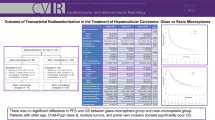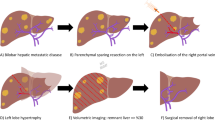Abstract
Purpose
To evaluate the effects of ablation strategies on local tumor progression (LTP) after microwave ablation (MWA) of hepatocellular carcinomas (HCCs) measuring 3–5 cm.
Materials and methods
Between December 2011 and May 2017, 71 HCC patients with 71 nodules treated by ultrasound(US)-guided percutaneous MWA were divided into parallel (group A) and crossed (group B) antenna placement groups. All patients underwent MWA using two antennas with four insertions. LTP and overall survival (OS) rates were compared between the two groups.
Results
The median follow-up time was 16.8 months. There was no significant difference in the complete ablation rate and treatment sessions between the two groups. LTP was diagnosed in 8 of 48 nodules (16.7%) in group A and 1 of 23 nodules (4.3%) in group B, with no significant difference between two groups (P = 0.115). The 1-, 2-, and 3-year OS rates were 88.5%, 79%, and 71.8% in group A and 93.8%, 87.5%, and 87.5% in group B, respectively (P = 0.236). Multivariate analysis showed that the tumor diameter (P = 0.017), the distance between the antennas (P = 0.032), and the total emission time (P = 0.015) were associated with LTP.
Conclusions
There were trends with lower LTP and improved OS in group B, despite the lack of statistically significant differences between the two strategies at a level of P < 0.05. The increase of distance between antennas and total emission time will facilitate reductions in LTP rate.



Similar content being viewed by others
Reference
Liang P, Jie Yu, Ming-De L, et al. (2013) Practice guidelines for ultrasound-guided percutaneous microwave ablation for hepatic malignancy. World J Gastroenterol 19(33):5430–5438
Bruix J, Sherman M (2011) Management of hepatocellular carcinoma: An update. Hepatology 53:1020–1022
Makuuchi M, Kokudo N, Arii S, et al. (2008) Development of evidence based clinical guidelines for the diagnosis and treatment of hepatocellular carcinoma in Japan. Hepatol Res 38:37–51
Sakaguchi H, Seki S, Tsuji K, et al. (2009) Endoscopic thermal ablation therapies for hepatocellular carcinoma: a multi-center study. Hepatol Res 39:47–52
Liang P, Yu J, Yu X-l, et al. (2011) Percutaneous cooled-tip microwave ablation under ultrasound guidance for primary liver cancer: a multicentre analysis of 1363 treatment-naive lesions in 1007 patients in China. Gut 61:1100–1101
Swan RZ, Sindram D, Martinie JB, Iannitti DA (2013) Operative microwave ablation for hepatocellular carcinoma: complications, recurrence, and long-term outcomes. J Gastrointest Surg 17:719–729
Wright AS, Sampson LA, Warner TF, Mahvi DM, Lee FT Jr (2005) Radiofrequency versus microwave ablation in a hepatic porcine model. Radiology 236:132–139
Wright AS, Lee FT Jr, Mahvi DM (2003) Hepatic microwave ablation with multiple antennae results in synergistically larger zones of coagulation necrosis. Ann Surg Oncol 10:275–283
Vogl TJ, Nour-Eldin NA, Hammerstingl RM, Panahi B, Naguib NNN (2017) Microwave ablation (MWA): basics, technique and results in primary and metastatic liver neoplasms. Rofo 189(11):1055–1066
Meloni MF, Galimberti S, Dietrich CF, et al. (2016) Microwave ablation of hepatic tumors with a third generation system: loco-regional efficacy in a prospective cohort study with intermediate term follow-up. Z Gastroenterol 54(6):541–547
Lu MD, Xu HX, Xie XY, et al. (2005) Percutaneous microwave and radiofrequency ablation for hepatocellular carcinoma: a retrospective comparative study. J Gastroenterol 40:1054–1060
Zhang L, Wang N, Shen Q, Cheng W, Qian GJ (2013) Therapeutic efficacy of percutaneous radiofrequency ablation versus microwave ablation for hepatocellular carcinoma. PLoS ONE 8(10):e76119
Yin XY, Xie XY, Lu MD, et al. (2009) Percutaneous thermal ablation of medium and large hepatocellular carcinoma: long-term outcome and prognostic factors. Cancer 115(9):1914–1923
Liu Y, Zheng Y, Li S, et al. (2013) Percutaneous microwave ablation of larger hepatocellular carcinoma. Clin Radiol 68:21–26
Jie Yu, Liang P, Xiao-ling Yu, et al. (2015) Local tumour progression after ultrasound-guided microwave ablation of liver malignancies: risk factors analysis of 2529 tumours. Eur Radiol 25:1119–1126
Mulier S, Ni Y, Jamart J, et al. (2005) Local recurrence after hepatic radiofrequency coagulation: multivariate meta-analysis and review of contributing factors. Ann Surg 242:158e71
Liu F-Y, Xiao-Ling Yu, Liang P, et al. (2010) Comparison of percutaneous 915 MHz microwave ablation and 2450 MHz microwave ablation in large hepatocellular carcinoma. Int J Hyperthermia 26(5):448–455
Jie Yu, Liang P, Xiao-ling Yu, et al. (2014) US-guided percutaneous microwave ablation versus open radical nephrectomy for small renal cell carcinoma: intermediate-term results 1. Radiology 270:880–887
Oshima F, Yamakado K, Nakatsuka A, et al. (2008) Simultaneous microwave ablation using multiple antennas in explanted bovine livers: relationship between ablative zone and antenna. Radiat Med 26(7):408–414
Kim YS, Lee WJ, Rhim H, et al. (2010) The minimal ablative margin of radiofrequency ablation of hepato-cellular carcinoma (> 2 and < 5 cm) needed to prevent local tumor progression: 3D quantitative assessment using CT image fusion. AJR Am J Roentgenol 195(3):758–765
Liu CH, Arellano RS, Uppot RN, et al. (2010) Radiofrequency ablation of hepatic tumours: effect of post-ablation margin on local tumour progression. Eur Radiol 20(4):877–885
Yu J, Liang P, Xiaoling Y, et al. (2011) A comparison of microwave ablation and bipolar radiofrequency ablation both with an internally cooled probe: results in ex vivo and in vivo porcine livers. Eur J Radiol 79:124–130
Poulou LS, Botsa E, Thanou I, Ziakas PD, Thanos L (2015) Percutaneous microwave ablation vs radiofrequency ablation in the treatment of hepatocellular carcinoma. World J Hepatol 7(8):1054–1063
Harari CM, Magagna M, Bedoya M, et al. (2016) Microwave ablation: comparison of simultaneous and sequential activation of multiple antennas in liver model systems. Radiology 278:95–103
Laeseke PF, Jr Lee FT, van der Weide DW, Brace CL (2009) Multiple-antenna microwave ablation: spatially distributing power improves thermal profiles and reduces invasiveness. J Interv Oncol 2(2):65–72
Thamtorawat S, Hicks RM, Yu J, et al. (2016) Preliminary outcome of microwave ablation of hepatocellular carcinoma: breaking the 3-cm barrier? J Vasc Interv Radiol 27:623–630
Sun Y, Cheng Z, Dong L, et al. (2012) Comparison of temperature curve and ablation zone between 915- and 2450-MHz cooled-shaft microwave antenna: Results in ex vivo porcine livers. Eur J Radiol 81:553–557
Teng W, Liu K-W, Lin C-C, et al. (2015) Insufficient ablative margin determined by early computed tomography may predict the recurrence of hepatocellular carcinoma after radiofrequency ablation. Liver Cancer 4:26–38
Wang X, Sofocleous CT, Erinjeri JP, et al. (2013) Margin size is an independent predictor of local tumor progression after ablation of colon cancer liver metastases. Cardiovasc Intervent Radiol 36(1):166–175
Liu F, Liang P, Xiaoling Yu, et al. (2013) A three-dimensional visualisation preoperative treatment planning system in microwave ablation for liver cancer: a preliminary clinical application. Int J Hyperthermia 29(7):671–677
Liu F, Cheng Z, Han Z, et al. (2017) A three-dimensional visualization preoperative treatment planning system for microwave ablation in liver cancer: a simulated experimental study. Abdom Radiol 42(6):1788–1793
Acknowledgements
This work was supported by three Grants: [2017YFC0112000] from National Key R&D Program of China, and [81627803, 81671710, 81471683, and 81622024] from the national nature science foundation of China.
Funding
This work was supported by the National Key R&D Program of China (2017YFC0112000), and the National Natural Scientific Foundation of China (81627803, 81622024, 81671710, and 81471683).
Author information
Authors and Affiliations
Corresponding authors
Ethics declarations
Conflict of interest
All the authors declare no conflict of interest.
Additional information
Publisher's Note
Springer Nature remains neutral with regard to jurisdictional claims in published maps and institutional affiliations.
Rights and permissions
About this article
Cite this article
Dong, Ln., Yu, Xl., Cheng, Zg. et al. Comparison of parallel and crossed placement of antennas in microwave ablation of 3–5 cm hepatocellular carcinoma. Abdom Radiol 44, 2293–2300 (2019). https://doi.org/10.1007/s00261-019-01959-8
Published:
Issue Date:
DOI: https://doi.org/10.1007/s00261-019-01959-8




